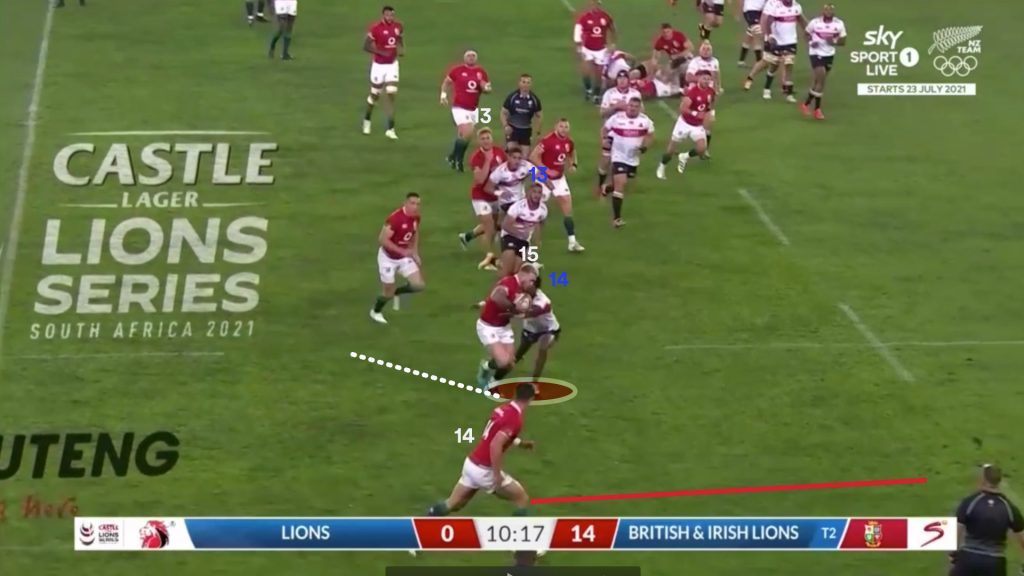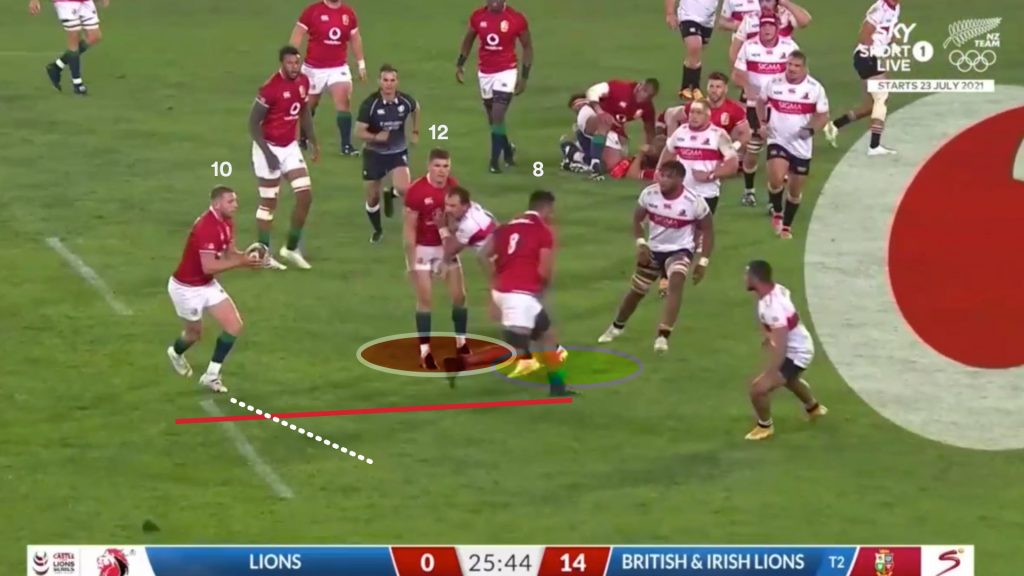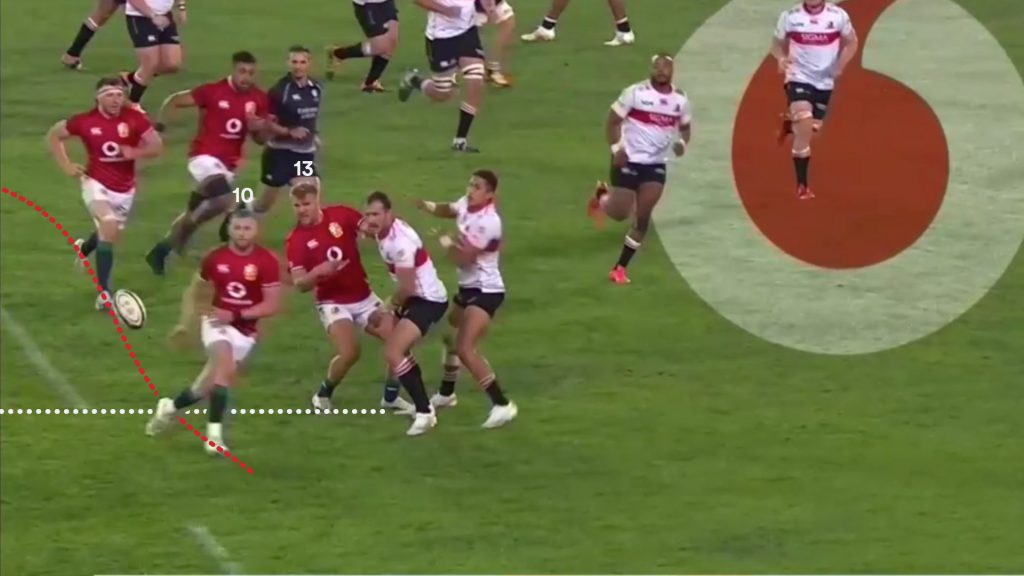The British & Irish Lions’ first game on South African soil saw a second game plan in as many weeks, as the tourists twisted the line-up to suit a new game plan.
The firepower of the visitors was far too much for the South African franchise Sigma Lions, who expectedly didn’t put up much of a fight after finishing in last place in their Rainbow Cup campaign.
The BIL had complete control of the gain line, rolling over the opposition at will, before stretching them out wide with swift and sharp attacking movements.
The disparity between the two sides was vast, the Sigma Lions defence some of the worst you will see at this level. They were passive in contact, driven backward frequently, overpowered by Test-match players. Slipped tackles, bad reads, poor alignments. You name it, this was like a training run for the British & Irish Lions against a local club footy side.
Little can be derived in terms of plotting future success in the Test series, but another building block has been laid as they were able to test another game plan, the rebirth of the 10-12 axis.
With Finn Russell and Owen Farrell combining at 10-12, they played a much more expansive game than against Japan, using the connection to find width with greater urgency. Some of the phase play patterns were the same, but the launch plays offered a new variant of Lions rugby utilising this new partnership.
There are some notable patterns to take note from this warm-up fixture, some of which looked designed specifically to handle the Springboks’ rush defence on the open side, where the likes of Jesse Kriel and Lukhanyo Am are required to jam with the ‘catch-up’ defender outside them, the wing.
As detailed by analyst Conor Wilson writing for RugbyPass, the Springboks’ defence has been great at shutting down basic rugby league-style ‘overs-unders’ running line patterns out wide.
When faced with the play against Wales, Jesse Kriel completely disregards the underneath runner Hadleigh Parkes and makes a beeline for Jonathan Davies out the back, shutting him down in a ball-and-all tackle and forcing play back inside towards the poachers.
The wing outside him, Aphiwe Dyantyi, is also there as insurance as the ‘catch-up defender’ to stop Wales getting the ball to the space in case the ball does move past Davies.
One of the solutions tabled by Wilson to beating this edge defence is using the skip pass, which Wales used early in their World Cup semi-final with promising results under Gatland.
The British & Irish Lions used a two-phase quick hit launch play on multiple occasions to target this open-side defence against the Sigma Lions, also trying to beat the catch-up defender with the skip-pass. It could be a tactic they are working on for the Test series.
For this play to work, it is all about speed of the recycle playing off a good gain line carry on first phase. On this occasion from the lineout, they used Hamish Watson (7) to truck the ball up into the midfield channel.


Watson’s strong carry gave the Lions a good platform to use the miss pass, and on the next phase the same way that is exactly what Finn Russell (10) tries.
Instead of running an unders-overs screen combination, the Lions present a standard backline with some depth. The opposition centre Manuel Rass (13) would have to shoot up extremely fast to close the play.
Russell’s deep miss-pass across the face of Chris Harris (13) to Stuart Hogg (15) beat both the centre and wing defenders, giving the Scotland full-back the outside shoulder of wing Jamba Ulengo (14).


Hogg is brought down in the tackle of Ulengo (14), but the opportunity was there to find Louis Rees-Zammit (14) unmarked with quick hands or an offload.

Beating the Springboks with the same two-phase quick hit will be much more difficult, as Kriel or Am will bring far more line speed with Kolbe outside him. However, without such an easy read for the Springbok centre, there is a higher chance of beating the edge pressure.
With an overs-unders combination, the defence has more time to rush as the playmaker takes the ball to the line waiting for the running lines to unfold.
Kriel or Am can immediately leave the flat option to their inside support and fly up to hit the man out the back, arriving at the same time as the ball.
With the deep miss-pass, they don’t have as much time to push forward as the ball is in and out of Russell’s hands upon catching it. It will be on the catch-up defender, the wing, to arrive to close on the full-back.
The risk of an intercept is low with the right amount of depth, and if Hogg is able to hold the catch-up defender, his outside winger will have some space.
Russell tried the miss-pass one more time in the first half, this time on the third phase going the same way on a slower developing launch pattern from a lineout.
After a deliberate overthrow to Harris, on the second phase we see Farrell (12) take over as first receiver with Russell (10) out the back and Taulupe Faletau (8) as a short option.

This is a classic Farrell set-up, a shape that he is an expert at running and one of the variations of the 10-12 axis that the Lions can build around.
England run this shape all the time, using Farrell’s ability to play a well-timed pullback pass. Using low hands, squaring up late, perhaps leaning away from the pass, Farrell is great at creating front-line contact to create blocking for the playmaker coming around the back, often George Ford.
This time around he plays Faletau (8) short, allowing Russell to bounce out and take over again on the third phase.

Russell used the skip-pass again to try and release Hogg on the outside, but this time Ulengo (14) has outside alignment and is able to contain him more effectively.


This tactic is worth persisting with as the Lions continue their warm-up run, as it does have an application against the Springboks as one of the ways to get width when playing to the open side.
It is also suited to Russell and Hogg’s skillsets, and with plenty of experience together they have a chance at finding the chemistry required to make the play more effective. Russell’s long pass can unlock Hogg’s running game on the edge. However, It will need to be sharpened to find success against South Africa’s No1 side.
The return of the 10-12 axis gives the Lions interchangeable pivots to structure attacking plans around, which we saw above.
Johnny Sexton and Farrell struck up a clinical partnership in New Zealand and Russell and Farrell have a similar opportunity now. Already there were moments of well-timed play that showed good cohesion.
As noted, Farrell is a highly skilled operator of the pullback pass, Russell has a great long cutout pass among other skills. Having them switch roles allows them to best utilise what they have to offer.
Russell floating out the back gives him the chance to link in as a second receiver a bit wider, where he could potentially throw the long ball with a bit more time under his belt.
On another deliberate overthrow to Harris from the lineout, the Lions slip into the same shape on the second phase. Farrell’s pullback pass draws contact from the front-line defence and Russell is offered a comfortable opportunity to make a play.



With time and space, Russell has all his options available from this position. He opted for the easy pass to next man Josh Adams (11) and takes the contact from the defender after the delivery.
Between Farrell and Russell, the touches were light but they interlinked together nicely and gave the Lions a chance to make something more on the edge. Unfortunately Adams’ long pass sails high and forward and nothing comes of it.


Everything does have to be taken with a grain of salt from this match as the aforementioned Sigma Lions’ defence was poor in nearly all areas.
Above you can see bad commit decisions on both Farrell and Russell long after the ball has gone, taking away key inside pressure from the defensive line. The opportunity for Adams was actually to cut back upfield and have a run between two sliding forwards with both midfielders removed.
They were able to run plays all day with almost no pressure. On this wrap play, the timing and depth from Farrell and Russell is good.
They don’t give away the ‘tell’ too early, they conceal their wrap lines late as Harris (13) takes what looks to be a crash ball to the line.



Russell got the return ball from Harris and found an easy path around the corner as both Lions’ defenders get jammed up.
The read is so bad from the defence that Russell just plays his second pass early anyway, as against tougher opposition you would expect at least one midfielder would swim past Harris (13) and switch on to Russell coming around the corner.

Farrell (12) is afforded an incredible amount of space around the edge and after his run, looked to thread a grubber through for Rees-Zammit (14).
If not for a last-ditch block from an outstretched foot, it would have likely been a try to Rees-Zammit, such is his speed and finishing ability.


Despite the almost non-existent defence, the chemistry between Farrell and Russell was promising in spurts. Neither is overbearing on one another and they were happy to defer or create for the other.
If the Russell-Farrell 10-12 axis is to be rolled out against the Springboks, they need to be tested by a stronger defence, which hopefully will come against the Sharks or Bulls.
The major difference between the Lions side who played Japan and the one that played on the weekend was the speed at which the ball could reach the edge with Russell and Farrell driving proceedings.
It was much more frequent for a variety of reasons against the South African club side.
Far more of the launch plays looked to get the ball to the fringes after one crash phase through the hands of the two playmakers, while the boot of Russell was also deployed frequently with the crossfield kick to take the aerial route. Whereas against Japan with Dan Biggar in the side, they played a lot of slow-developing patterns, centred around forward-carrying.
They did play up the middle too against the Sigma Lions, playing forward runners around the corner a couple times before releasing the backs. On either approach to attacking width, slow or fast, they were rarely troubled by the hosts.
After two games, we have seen two distinct, separate game plans which is healthy for a Test series where you will need to adapt throughout.
There will likely be more experimentation to come but hopefully the Russell-Farrell partnership is given more time to come to fruition.
More stories from Ben Smith
If you’ve enjoyed this article, please share it with friends or on social media. We rely solely on new subscribers to fund high-quality journalism and appreciate you sharing this so we can continue to grow, produce more quality content and support our writers.



Comments
Join free and tell us what you really think!
Sign up for free